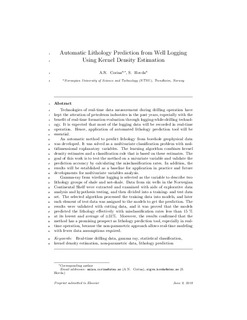| dc.contributor.author | Corina, Anisa Noor | |
| dc.contributor.author | Hovda, Sigve | |
| dc.date.accessioned | 2019-12-17T11:32:41Z | |
| dc.date.available | 2019-12-17T11:32:41Z | |
| dc.date.created | 2018-08-16T16:15:26Z | |
| dc.date.issued | 2018 | |
| dc.identifier.citation | Journal of Petroleum Science and Engineering. 2018, 170 664-674. | nb_NO |
| dc.identifier.issn | 0920-4105 | |
| dc.identifier.uri | http://hdl.handle.net/11250/2633616 | |
| dc.description.abstract | Technologies of real-time data measurement during drilling operation have kept the attention of petroleum industries in the past years, especially with the benefit of real-time formation evaluation through logging-while-drilling technology. It is expected that most of the logging data will be recorded in real-time operation. Hence, application of automated lithology prediction tool will be essential.
An automatic method to predict lithology from borehole geophysical data was developed. It was solved as a multivariate classification problem with multidimensional explanatory variables. The learning algorithm combines kernel density estimates and a classification rule that is based on these estimates. The goal of this work is to test the method on a univariate variable and validate the prediction accuracy by calculating the misclassification rates. In addition, the results will be established as a baseline for application in practice and future developments for multivariate variables analysis.
Gamma-ray from wireline logging is selected as the variable to describe two lithology groups of shale and not-shale. Data from six wells in the Norwegian Continental Shelf were extracted and examined with aids of explorative data analysis and hypothesis testing, and then divided into a training- and test data set. The selected algorithm processed the training data into models, and later each element of test data was assigned to the models to get the prediction. The results were validated with cutting data, and it was proved that the models predicted the lithology effectively with misclassification rates less than 15% at its lowest and average of ± 31%. Moreover, the results confirmed that the method has a promising prospect as lithology prediction tool, especially in real-time operation, because the non-parametric approach allows real-time modeling with fewer data assumptions required. | nb_NO |
| dc.language.iso | eng | nb_NO |
| dc.publisher | Elsevier | nb_NO |
| dc.rights | Attribution-NonCommercial-NoDerivatives 4.0 Internasjonal | * |
| dc.rights.uri | http://creativecommons.org/licenses/by-nc-nd/4.0/deed.no | * |
| dc.title | Automatic lithology prediction from well logging using kernel density estimation | nb_NO |
| dc.type | Journal article | nb_NO |
| dc.type | Peer reviewed | nb_NO |
| dc.description.version | acceptedVersion | nb_NO |
| dc.source.pagenumber | 664-674 | nb_NO |
| dc.source.volume | 170 | nb_NO |
| dc.source.journal | Journal of Petroleum Science and Engineering | nb_NO |
| dc.identifier.doi | 10.1016/j.petrol.2018.06.012 | |
| dc.identifier.cristin | 1602488 | |
| dc.description.localcode | © 2018. This is the authors’ accepted and refereed manuscript to the article. Locked until 11.7.2020 due to copyright restrictions. This manuscript version is made available under the CC-BY-NC-ND 4.0 license http://creativecommons.org/licenses/by-nc-nd/4.0/ | nb_NO |
| cristin.unitcode | 194,64,90,0 | |
| cristin.unitname | Institutt for geovitenskap og petroleum | |
| cristin.ispublished | true | |
| cristin.fulltext | original | |
| cristin.fulltext | postprint | |
| cristin.qualitycode | 2 | |

